At the Saint-Etienne Biennale, work is not what it used to be
Published 21 March 2017 by Annick Rivoire
Somewhere between robotization, uberization and co-design, the 10th Saint-Etienne Design Biennale in France presents a spectacular panorama of “shifting work paradigms”. Fablabs have a place of honor.
Saint-Etienne, special report (words and photos)
Dive into the future with a theme as old as the world, radiates the 10th Saint-Etienne International Design Biennale, which embraces a stunning panorama of shifting work paradigms under the title Working Promesse. It’s a mixture of prospectivism and undeniable instability in our contemporary world: mass unemployment has already set in, just as robotization has started up, and algorithms rule our data. But this observation is also informed by fiction (design fiction, science-fiction and even robot-fiction) to question the end of work.
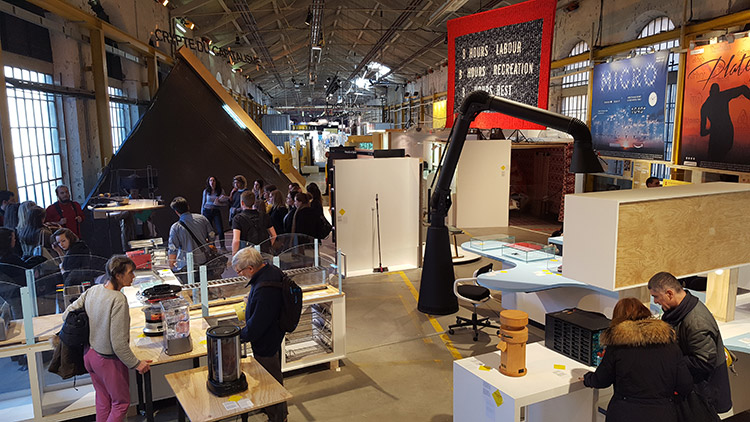
For Olivier Peyricot, scientific director of the Biennale, design must “question society about its choices”. Mission accomplished: we emerge from this formidable Biennale (no doubt the least “object design” oriented of them all), enriched by multiple points of view—current, ironic, artistic, sometimes activist, often cerebral—that neither sugar-coat nor minimize our dependence on GAFA and the dehumanization of work in the age of Amazon’s Mechanical Turk (the virtual space of micro-work for $2/hour).
The “second age” of machines
The City of Design hosts ten exhibitions on the former site of an arms factory called La Manufacture, iconic of a fallen past. Despite its dazzling display as a design city (Unesco label), Saint-Etienne is marked by its difficult economic past (the Pigeot des Houillères de la Loire well closed in 1983, Manufrance in 1986, La Manu along with it). As soon as you get off the train, you see construction sites, buildings growing out of the ground, neighborhoods undergoing an overhaul. But this apparent urban vitality doesn’t completely mask the social misery of a city that never really took the plunge into the new industrial “revolution”, this “second age” of machines and of shifting work paradigms. On the street, passers-by are more familiar with La Manu than with the Biennale (yet it’s the same space, that attracts more than 200,000 visitors from well beyond France’s Loire department).
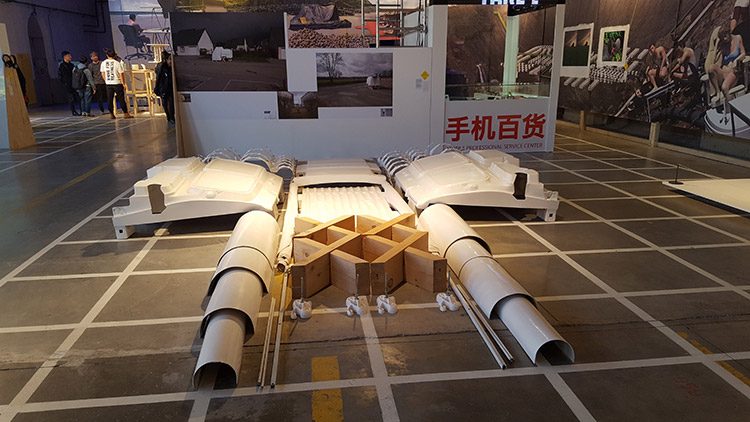
Unemployment and deindustrialization, uberized economy, new forms of precarity, “connected labor”, proliferation of third-spaces for new forms of collaboration… The range of shifting work paradigms is so vast that Olivier Peyricot, also director of the City of Design’s research pole, refuses the pretention of exhaustivity to focus on two “key” symptoms: “digital labor” and “new organization of work through the existence of third-spaces”. These two points recur in the “path” of ten exhibitions that express diverse, shattered and exploded viewpoints on the world of work at the City of Design, as well as at multiple entry points spread around town.
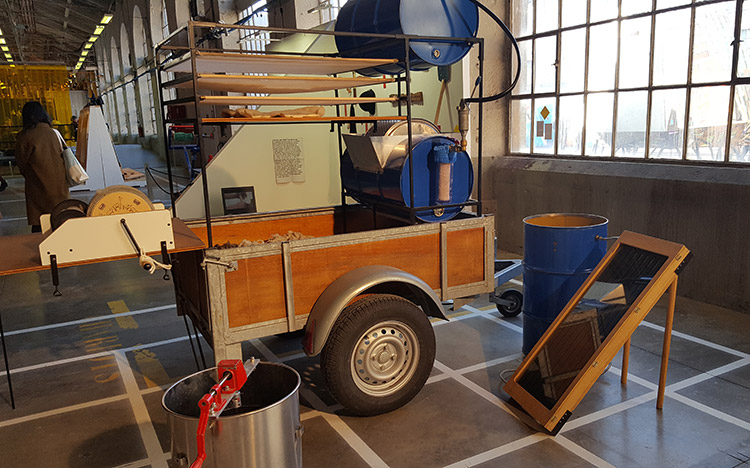

In the vast warehouse used to introduce visitors to this Biennale, the Panorama of shifting work paradigms spotlights digital labor, in the larger sense of networking and digitizing our activities. First paradox, we enter through the kitchen, a metaphor for the Taylor System, this space that “offsets industrial tasks” by imitating the procedures developed in factories to optimize housework. Domotics, food dehydrator (Fruit Jerky by Klarstein, 2016), domestic chain… The hypothesis is that the home is the first space where the distinction between industrial and manual labor is blurred. If our household appliances change our lives, they also turn us into vulgar terminals! The future is already here—we have allowed into our homes this part of digital technology that transforms consumers into workers, whether we like it or not.
Critical and caustic design
Many examples, both design objects and art pieces, contribute to illustrating this highly engaged point of view on the digital shift in mindsets and practices. Like Sac à dos du PNJ by France Tendance (2016), a polyvalent cardboard silhouette backpack worn by the non-playing character in a video game, who provides equipment and aid to players). Like The Sheep Market by Aaron Koblin, painted paper that reproduces 10,000 drawings of sheep by the very precarious Mechanical Turk workers, where “creative work has lost its value”. In another allusion to sheep, this time as a solution, Felt Like a Sheep by Guilhem de Cazenove (2015) is a nomadic wool workshop in a wagon that “reformulates the short circuit of traditional farming with a makerspace”.
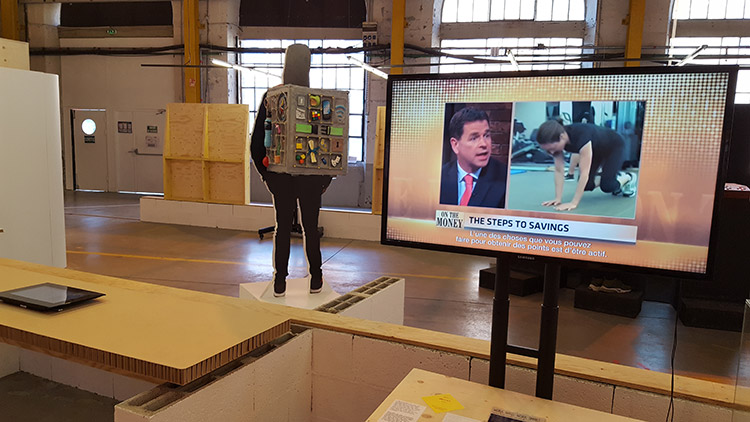
The offbeat and critical gaze of artists and designers on our modern world serves as both a burning and caustic observation. Burning, like Shanzai Archeology by Nicolas Maigret, Clément Renaud and Maria Roszkowska (2015-2017), which showcases a “collection of telephones derived from technological interbreeding made in China”, demonstrates by the absurd how Shenzhen has forced its way to become the electronics capital of the world through fake goods and reverse engineering. Caustic, like the 7 actions de dépense by Jules Bouchier-Végis (2015), which include a Headbanger Bomb to expend oneself through headbanging and thus explore “play within the creative process”, or Selfie Broom by Ranjiv Sirpal, the ultimate accessory for domestic selfies.
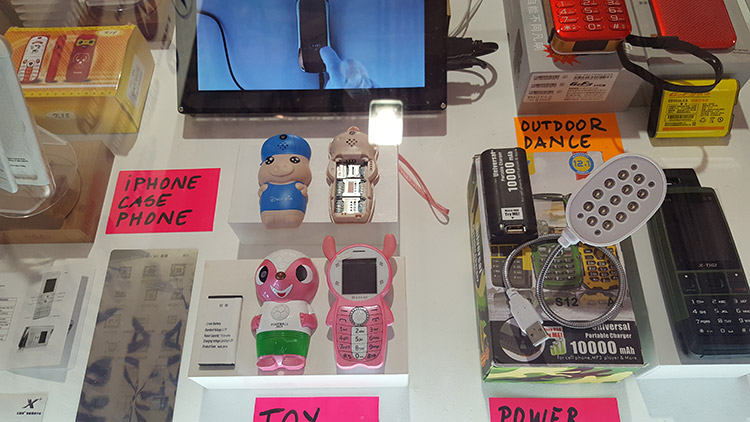
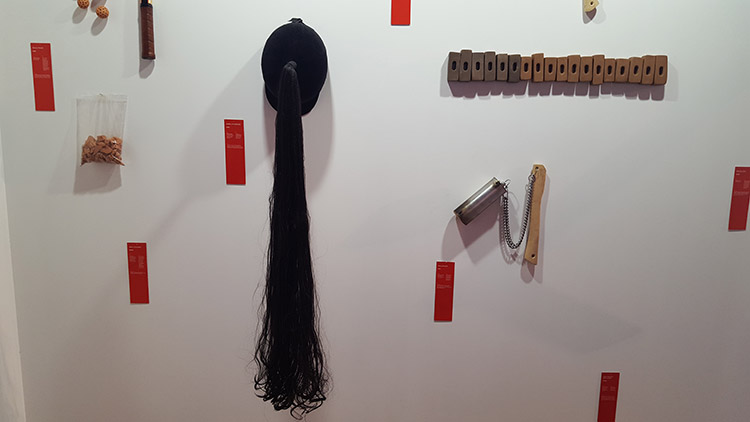
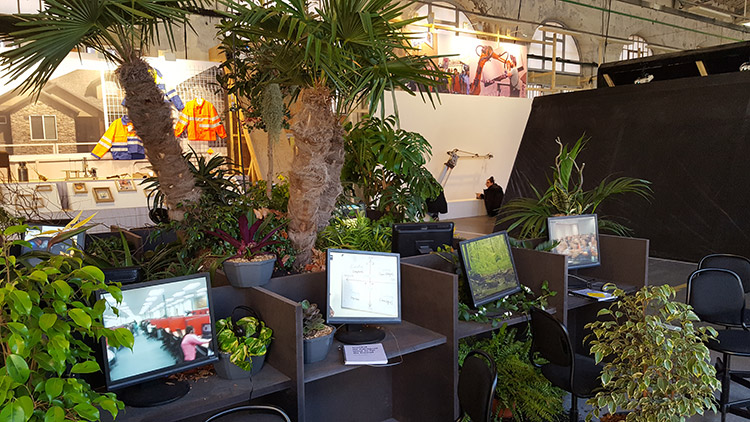
Some push this logic of work for all to the extreme (Et Dieu créa la TPE à la faveur d’une conjoncture plus porteuse, by Serge Lhermitte, 2011-2016) or exaggerate our forms of dependence on work. Stéphane Degoutin and Gwenola Wagon installed a call center invaded by the jungle, where the screens display looped videos and images glorifying ways to escape work (office chair contests and other yoga sessions in chairs), which they call Neoteny Institute for the end of work. Others extrapolate on our needs in the “post-work” age, as speculative designer Thomas Thwaites installed Voodoo Economics, an absurd machine that produces “the souvenir shop of our uncertain future”—revolving 3D printing of nonsensical objects…

Cradle of deindustrialization
After diving into this disrupted present, we pass through Detroit café, that other city symbolic of deindustrialization rescued by collectives, design and third-spaces, followed by the Biennale “rest” room, the Stalker Zone by Didier Fiuza Faustino, Alain Damasio and Norbert Merjagnan, Extravaillance Working Dead, where robot-plants welcome you with their soothing words, between hypnosis and SF. In a very relaxed position, we listen to microfictions by a group of authors who observe our present from 200 years in the future. Chilling and radical.
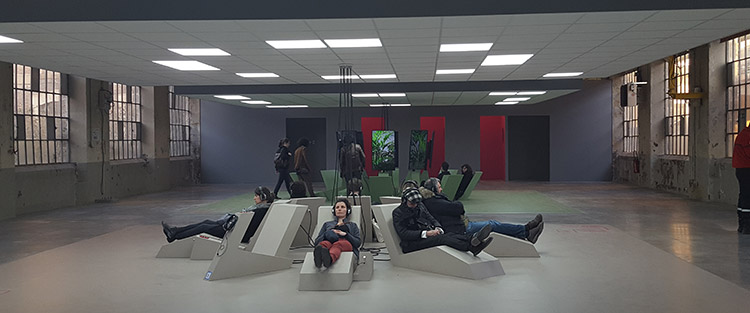
TAZ for third-spaces
We can also seek comfort directly inside a third-space such as the exhibition-installation Fork the World. It’s almost like being in a fablab, with its reclaimed sofa, bicycle cart and large panels of laminated wood. One of the strong points of this Biennale is that each exhibition contains its own world, its own esthetics, and from this apparent clutter emerges a fundamentally coherent idea. Here, the World Trusting Foundation collective (which brings together around Yoann Duriaux from Movilab third-spaces from Lyon and Saint-Etienne, the research center at City of Design and design collective RDC for the scenography), curated a space anchored in the very concrete, with a workshop table for “live” tinkering, an area for discussion (in the late morning and afternoon) and large signs, to create a TAZ (temporary autonomous zone, as defined by Hakim Bey).

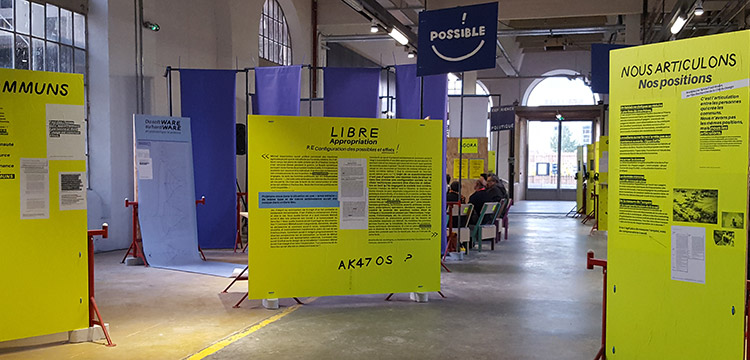
Those who are unfamiliar with the world of DIY, makers and tinkering will discover a bunch of docs on a few exemplary communities (Ouagalab in Burkina Faso, Funky Citizens in Romania, Calafou in Barcelona, Gynepunk…). They can also get a close-up look at rare objects from the labs (prototypes of the echo-stethoscope by Echopen or a farming vehicle by Atelier Paysan, which promotes ecology in farming and offers training in DIY construction for farmers).
It’s less of an exhibition than a living space about people and their dreams of “emancipation by doing”. Slogans are humorous (“Just DIY it”, “Queeriser Mad Max”), while personalities such as Lionel Maurel, blogger and cofounder of Savoirscom1 and La Quadrature du Net, an organization well known for its defense of public liberties on the Internet, recalls their experience of “forming a community around the library project” Biblio Debout, the shared library of Nuit Debout.
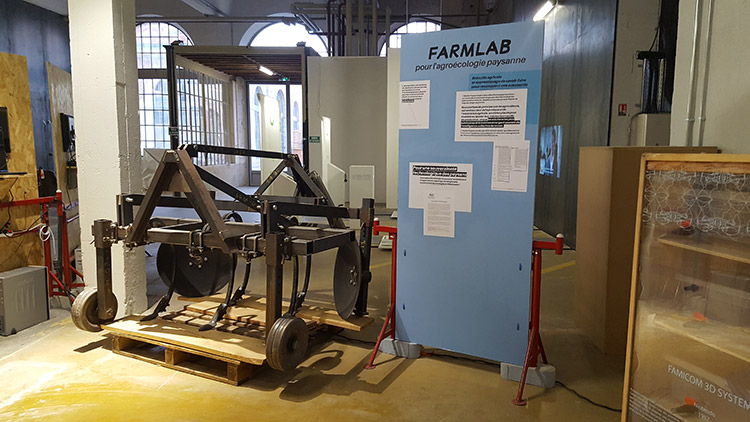
Friction points
Of course, there were obvious points of friction between spaces in this mutating design Biennale. Ludovic Burel and Ju Hyun Lee’s radical Cut & Care—which only presents objects for “horizontal workers” (as more and more of us work at home, why not lying down?), from the lounge chair to the coffin—rubs against the darker vision of Player Piano, in which work no longer exists, or only as delegated to underground machines and thus invisible to common mortals. The exhibition offers a subjective atlas of a civilization that is liberated from the cults of work, technology and property. A huge panoramic turnstile projects onto a few screens, each presenting a trace of the struggles around labor and technology (where we learn the destiny of the Post-It, a failed prototype whose current success is mere coincidence).
Detroit reinvented
It also rubs against the festive vision of productions by Detroit, the city of the fallen automobile industry, revived by its collectives, who reinvented design, work and life. Who knew that hipster-friendly Carhartt brand jeans were born in Detroit from prototyping resistant and ergonomic work clothing? Or that the old industry we thought was dead is collaborating with creatives on new uses, such as this enormous cushion made from recycled foam by experimental designers Thing Thing, who are working with auto equipment manufacturer Lear Corporation to create furniture using the waste from its foam production unit Lear Corp. Or these Homes Eyewear glasses made out of oak wood reclaimed from demolitions, made in Detroit since 2012. The flashy, clinky bicycles made by East Side Riders (a group of about 30 biker makers of custom bikes) bring a welcome touch of kitsch. Because ecology and upcycling utopia have many esthetics, and you can also make some noise with your DJ bike!
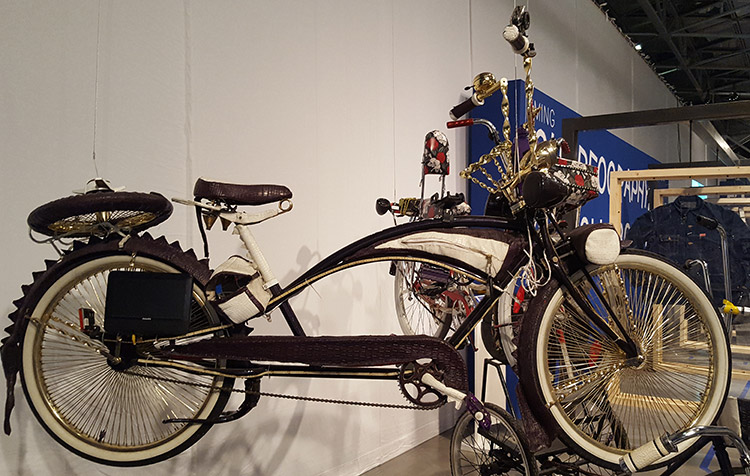
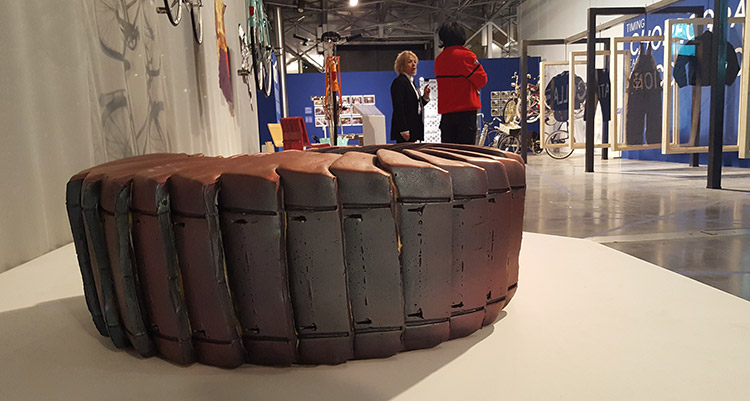
Out on the street
Yet despite all this friction, amidst the crisis, shifting paradigms and instability, new collective, creative and inventive practices are emerging. We took a walk down Rue de la République, where the Biennale decided to rehabilitate through design a major artery lined with closed shops, right downtown.
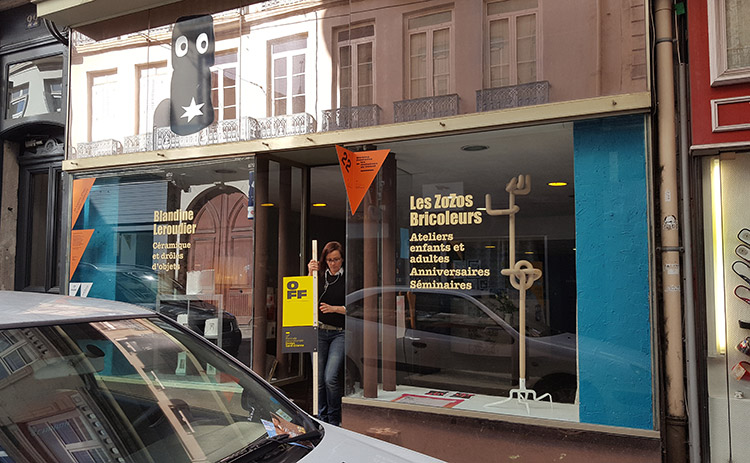
A dozen shops were temporarily remodeled to host about 40 projects for the duration of the event. These range from a co-op organic supermarket to La Meute collective’s Bons baisers de Saint-Etienne fake shop of real souvenirs (including racks featuring postcards of pastoral images of a bygone era that never existed), and shared experiences (ceramic workshop, living lab, re-employment shop, coworking and lecture space…). We met a small shop owner and a pharmacist, both resistant to the decline, who were visibly delighted with the deal, even if it lasts only the time of the Biennale. It’s also a chance, for these Saint-Etienne residents who have never set foot inside the Biennale, to rub shoulders directly with design.
10th Saint-Etienne International Design Biennale, from March 9 to April 9
